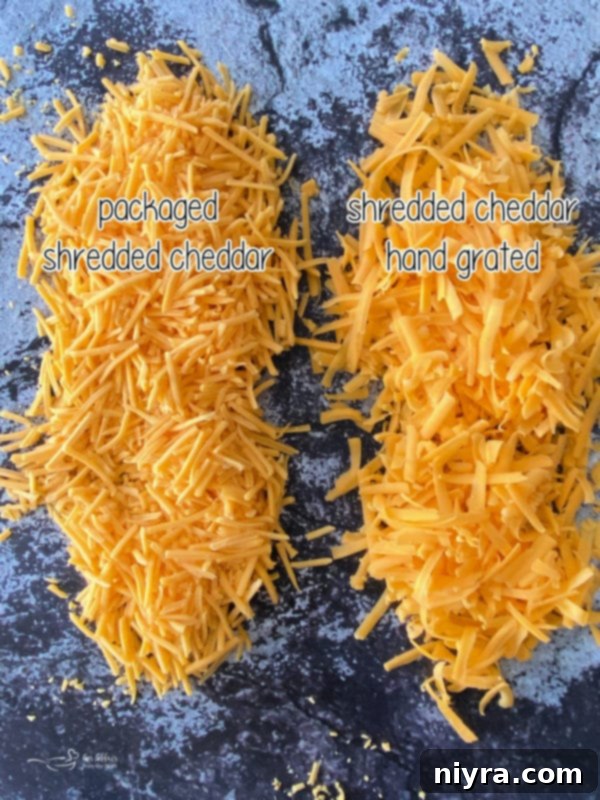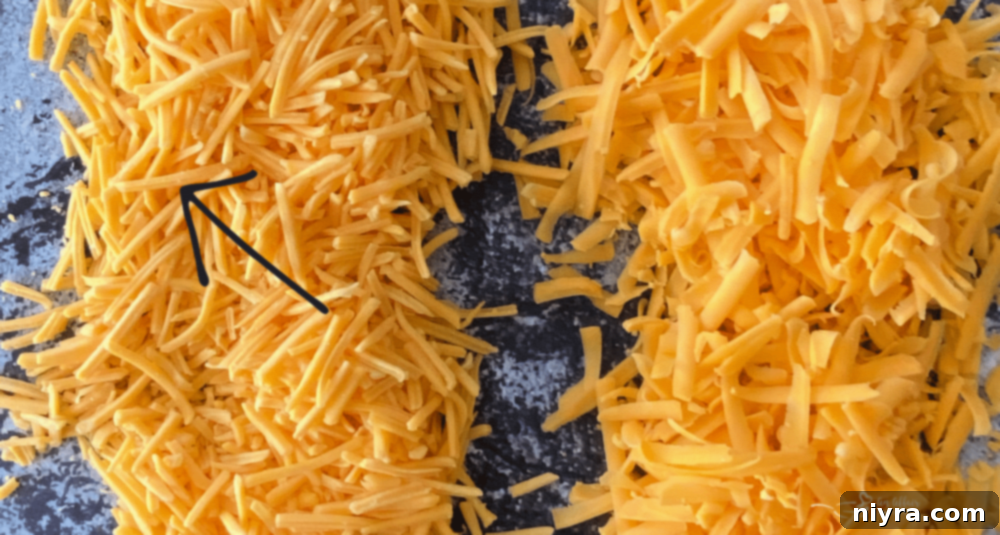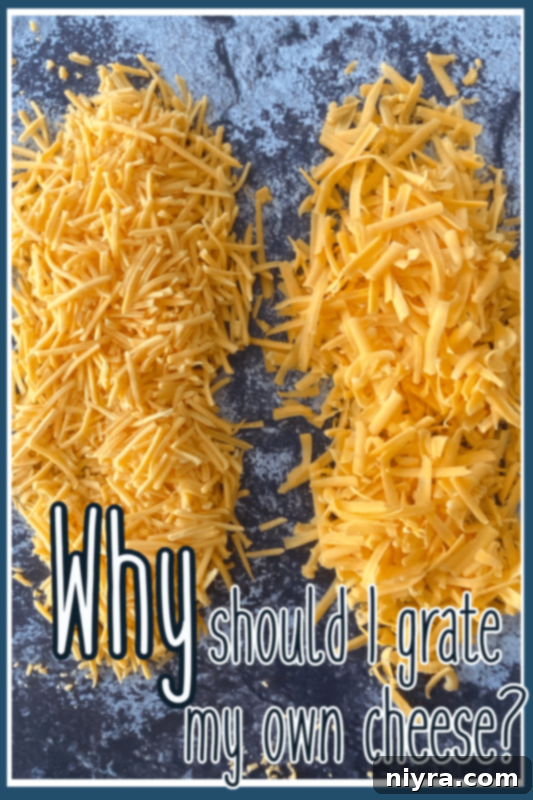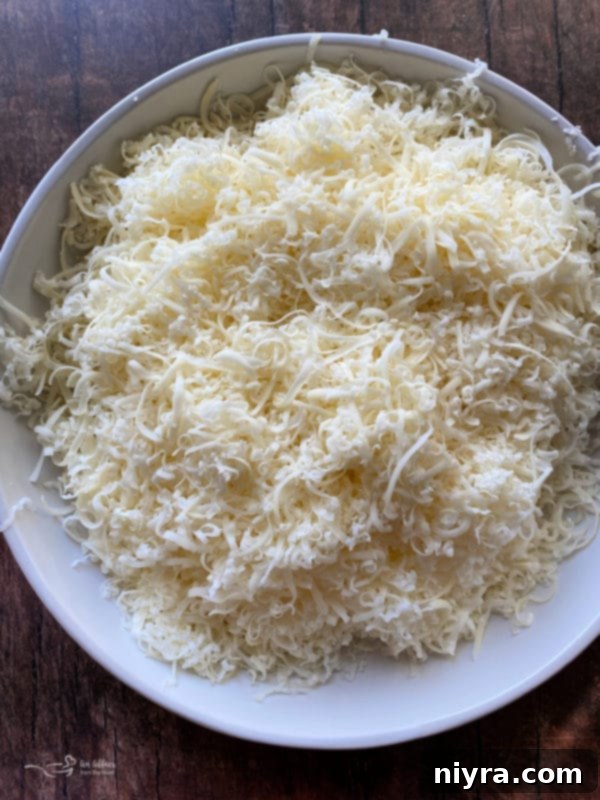Grating your own cheese is a simple culinary practice that offers a myriad of benefits far beyond mere convenience. While pre-shredded cheese might seem like a time-saver, taking a few extra moments to grate a block of cheese yourself can significantly elevate the taste, texture, and overall quality of your meals. It’s not just about a better culinary experience; it’s also about making a more economical and health-conscious choice. This comprehensive guide will delve into all the compelling reasons why you should grate your own cheese, explore the various types of cheese graters available, offer essential grating tips, and even share some delectable cheesy recipes to inspire you. Get ready to transform your cooking with the incomparable goodness of freshly grated cheese!

Why Grate Your Own Cheese? Unlocking Superior Flavor, Melt, and Value
When faced with the choice between a block of cheese and a bag of pre-shredded varieties, many reach for the latter for its perceived convenience. However, this seemingly simple decision carries significant implications for your food’s flavor, texture, and even your wallet. Let’s uncover the compelling reasons why grating your own cheese is a game-changer in the kitchen.
1. Experience Unrivaled Flavor and Freshness
Have you ever wondered why store-bought shredded cheese never clumps together, even after sitting in the fridge for days? The secret lies in a common additive: cellulose. Cellulose, often derived from wood pulp, is used as an anti-caking agent to prevent the shredded cheese from sticking. While generally recognized as safe for consumption, this coating can diminish the natural flavor of the cheese, creating a slightly chalky or bland taste compared to its freshly grated counterpart. When you grate cheese directly from a block, you get nothing but pure, unadulterated cheese, allowing its true, rich flavor profile to shine through in every bite. The aroma is more pronounced, and the taste is noticeably fresher and more authentic, making a world of difference in your culinary creations.

2. Achieve the Perfect Melty Consistency
Beyond taste, the anti-caking agents and added starches in pre-shredded cheese also interfere with its melting properties. These additives prevent the cheese from achieving that smooth, creamy, and irresistible melt that we all crave in dishes like gratins, casseroles, pizzas, and grilled cheese sandwiches. Instead, pre-shredded cheese tends to melt into a slightly grainy, sometimes greasy, and often less cohesive mass. Freshly grated cheese, on the other hand, melts beautifully and evenly, transforming into a luscious, velvety sauce that binds ingredients together and enhances the overall mouthfeel of your dish. For any recipe where a perfect melt is crucial, grating your own cheese is absolutely essential for achieving culinary perfection.

Observe this visual comparison of two identical brands of medium cheddar cheese. The image on the left features pre-shredded cheese from a package, while the right displays cheese freshly grated by hand. At a glance, the difference might seem negligible. However, a closer inspection reveals a key distinction:

Upon zooming in, you can clearly see a fine, white coating on the pre-shredded cheese. This is the cellulose and other anti-caking agents that prevent the shreds from sticking together. It’s this very coating that compromises both the flavor and melt of the cheese.

3. A More Economical and Savvy Choice
It might seem counterintuitive, but buying a block of cheese and grating it yourself is almost always more cost-effective than purchasing the pre-shredded bags. While an 8-ounce block and an 8-ounce bag might appear to be the same amount, you’re actually paying a premium for the “convenience” of having someone else do the shredding for you. This convenience charge can add a significant percentage to the price per pound. Over time, these small differences add up, leading to substantial savings. By investing in a block of cheese, you not only get more actual cheese for your money but also avoid paying for unnecessary processing and packaging. It’s a smart financial move for any home cook.
4. Wider Variety and Culinary Freedom
When you limit yourself to pre-shredded cheese, you’re often restricted to a handful of popular varieties like cheddar, mozzarella, or a generic “Mexican blend.” The world of cheese, however, is vast and exciting, offering hundreds, if not thousands, of unique flavors and textures. Consider the sheer diversity: there are over 450 types of Swiss cheese alone! Grating from a block opens up an entire universe of possibilities, allowing you to experiment with artisanal cheeses, less common varieties, and tailor your cheese choice precisely to your recipe. Whether you need a delicate Pecorino Romano for pasta, a sharp Gruyère for a French onion soup, or a creamy Havarti for a sandwich, buying in blocks gives you the freedom to choose exactly what your dish demands, enriching your cooking with unparalleled depth and nuance.
5. A Healthier and More Natural Option
As we’ve discussed, pre-shredded cheeses often contain additives like cellulose and various starches. While these are generally deemed safe for consumption, they are still processed ingredients that wouldn’t naturally be found in cheese. For those who prioritize a clean diet and wish to avoid unnecessary chemicals and preservatives, grating your own cheese is a straightforward way to ensure you’re consuming only pure dairy. You control what goes into your food, guaranteeing a more natural and wholesome ingredient for you and your family.

Pin This Informative Post on Grating Your Own Cheese!
Don’t let these valuable insights slip away! Pin this post to your favorite Pinterest board so you can easily reference it whenever you need a reminder of the benefits of freshly grated cheese or tips on how to master the art of grating.

Expert Cheese Grating Tips for Perfect Results
Grating cheese might seem straightforward, but a few simple tips can make the process easier, safer, and yield superior results.
- Chill Your Cheese: Slightly chilled cheese is firmer and much easier to grate cleanly. If your cheese block is at room temperature, pop it in the freezer for about 15-20 minutes before grating. This firms it up, preventing it from gumming up the grater and making clean shreds.
- Let the Grater Do the Work: You don’t need immense strength to grate cheese effectively. Hold the cheese block firmly but apply gentle, consistent pressure. Allow the sharp blades of the grater and the natural weight of the cheese to do the hard work. Pushing too hard can make the process more difficult and less efficient.
- Use a Firm Grip and Proper Angle: Ensure you have a stable surface for your grater. Hold the cheese block with your dominant hand and the grater securely with your other. Grate at a slight angle for better leverage and to guide the cheese down the blades smoothly.
- Safety First: Always be mindful of your fingertips! As the cheese block gets smaller, consider using a food holder or even wearing a protective glove to keep your hands safe from the sharp blades.
Choose the Right Blade for the Job: Most graters come with multiple blade sizes, and understanding their purpose is key to achieving desired textures:
- Fine Shred/Zester (Smallest Holes): Ideal for hard cheeses like Parmesan or Pecorino Romano, producing a powdery, almost sandy texture. Perfect for garnishing pasta, salads, or creating a fine zest from citrus.
- Medium Shred (Medium Holes): This versatile size is excellent for semi-hard cheeses like cheddar, mozzarella, or Monterey Jack. It creates consistent shreds that melt evenly and quickly, making it perfect for pizzas, tacos, and casseroles.
- Coarse Shred (Largest Holes): Use this setting for larger, more substantial shreds, often preferred for dishes where you want the cheese to be a prominent texture, such as in lasagna, hearty gratins, or some types of baked macaroni and cheese. It also works well for shredding vegetables like carrots or potatoes.

Exploring the Best Types of Cheese Graters
To make your cheese grating experience as efficient and enjoyable as possible, having the right tool is paramount. There’s a wide array of cheese graters on the market, each designed with specific uses and preferences in mind. Here are some of the most popular and effective types, along with their advantages:
- Four-Sided Stainless Steel Upright Box Grater: This is a classic kitchen staple, known for its versatility. It typically features four different grating surfaces (fine, medium, coarse, and sometimes a slicing blade), making it suitable for a wide range of cheeses and other foods. Its stable, upright design makes it easy to use over a bowl or cutting board. It’s a great all-rounder for most home cooks.
- Rotary Cheese Grater: Perfect for harder cheeses like Parmesan, a rotary grater uses a hand crank to press cheese against a rotating drum with blades. This design is exceptionally safe, as your fingers are kept away from the cutting surface. It produces fine, consistent shreds or powdery results, ideal for garnishing pasta or salads. There are both manual and electric versions available.
- Manual Rotary Cheese Grater with Interchangeable Blades: An upgraded version of the standard rotary grater, these models offer multiple interchangeable drums for different shred sizes (fine, coarse, slicing). This enhances its versatility, allowing you to achieve various textures for different culinary applications, all while maintaining the safety benefits of the rotary design.
- Shredder Attachment for KitchenAid Stand Mixer: For those who frequently use large quantities of freshly grated cheese (think big batches of lasagna, casseroles, or pizza night), a stand mixer attachment can be a lifesaver. These attachments quickly and effortlessly shred large blocks of cheese, significantly reducing prep time and manual effort. They are typically robust and efficient, turning a laborious task into a quick one.
- Flat Stainless Steel 3-in-1 Grater: These handheld graters often feature three distinct grating surfaces on a single flat plane (fine, medium, coarse). They are compact, easy to store, and great for smaller tasks or when you don’t need the bulk of a box grater. Their simple design makes them easy to clean.
- Hand-Held Graters (Microplane Style): While the term “hand-held grater” can apply broadly, this often refers to the zester-style Microplane grater. Known for its incredibly sharp, tiny blades, it excels at producing very fine, fluffy shreds of hard cheese (like Parmesan) and is also fantastic for zesting citrus fruits, grating ginger, or finely mincing garlic. It’s perfect for adding a delicate finish to dishes.
Choosing the right grater depends on your cooking habits, the types of cheese you frequently use, and your desired level of convenience and efficiency.
Cheesy Recipes We Love (Perfect with Freshly Grated Cheese!)
Now that you’re equipped with the knowledge and tools for superior cheese grating, it’s time to put that freshly shredded goodness to use! Nothing enhances a cheesy dish quite like the rich flavor and perfect melt of homemade grated cheese. Here are some of our absolute favorite recipes that truly shine with the addition of freshly grated cheese. Prepare to indulge!
- Philly Cheese Steak Soup (pictured above, where a creamy, even melt is essential)
- Swiss Cheese Dip
- Beer Cheese Sauce (perfect for a smooth, velvety texture)
- Arancini (Three Cheese Fried Risotto Balls – taste the difference of fresh cheese!)
- Summer Sausage Cheese Ball
- Four Cheese Roasted Garlic Bread
- Bacon & Swiss Quiche
- Philly Cheese Steak Stuffed Peppers
- Sausage Pretzel Bombs with Mustard Cheese Sauce
- Texas Trash Dip

Keeping Your Freshly Grated Cheese Fresh
You’ve taken the time to grate your own cheese, and now you have some delicious leftovers. Proper storage is crucial to maintain its freshness and prevent spoilage. Unlike its pre-packaged counterparts, freshly grated cheese lacks the preservatives that extend shelf life, so it requires a bit more attention.
- Refrigeration: The best way to store leftover freshly grated cheese is in an airtight container in the refrigerator. This minimizes exposure to air and moisture, which can accelerate spoilage. A glass container with a tight-fitting lid or a heavy-duty zip-top bag with all air squeezed out works wonderfully. Aim to use refrigerated grated cheese within three to five days for optimal flavor and quality.
- Freezing for Longer Storage: If you’ve grated a larger quantity than you anticipate using within a few days, freezing is an excellent option. Spread the grated cheese in a single layer on a baking sheet and freeze for about an hour until it’s firm. This prevents the shreds from clumping together into a solid block. Once partially frozen, transfer the cheese to a freezer-safe airtight container or a heavy-duty freezer bag, removing as much air as possible. Frozen grated cheese can maintain its quality for up to 30 days. When you’re ready to use it, you can often add it directly to hot dishes without thawing.
- Avoid Excess Moisture: Moisture is the enemy of fresh cheese, as it can encourage mold growth. Ensure your cheese is dry before storing, and always use clean, dry containers.

In conclusion, while the allure of pre-packaged shredded cheese’s convenience is undeniable, the advantages of grating your own cheese are simply too significant to ignore. From its superior taste and incredible melt to the economic savings, wider variety, and healthier profile, freshly grated cheese consistently outperforms its pre-shredded counterparts. We understand that time constraints sometimes dictate our choices, and in those moments, store-bought shredded cheese certainly has its place. However, for those instances where flavor, texture, and quality truly matter, you simply can’t beat the pure deliciousness that comes from grating your own cheese. It’s a small effort with enormous culinary rewards, transforming everyday meals into something truly special. Happy grating!

